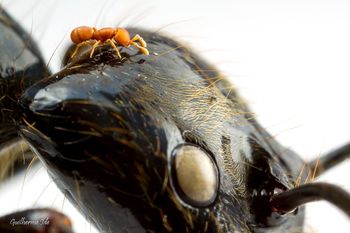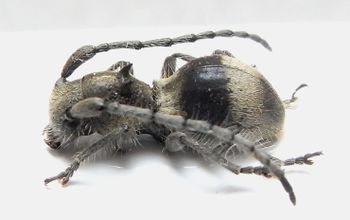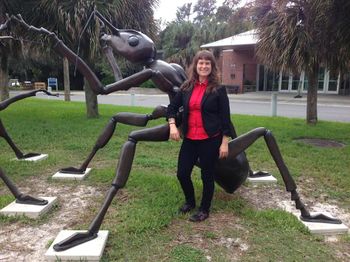Featured Images
| An image from the 2018 revision of the Carebara of the Malagasy Region by Azore and Fisher. [1]. |
December 2018
 Ants, Daisy Chains and Leptogenys. © Stéphane De Greef, used with permission. |
Workers of the Leptogenys chalybaea species group are swarm raiders that primarily prey on large millipedes. The ants attack and immobilize these relatively large prey and can then form chains of workers to drag their newly acquired trove of nutrients back to the nest (Peeters & De Greef 2015). The Leptogenys chalybaea species pages includes a youtube video of this behavior that has been viewed more than 7 million times! |
October 2016

|
The Big and the Small. A Discothyrea sexarticulata worker placed on Dinoponera australis. Photo by Guilherme Ide (MZUSP). |
August 2016

|
Leptogenys diminuta with milliped prey, India. Photo by Manoj Vembayam. |

|
Myrmoteras worker from Danum Valley, Sabah, Malaysia. The trigger hair, used to release the mandibles from their open to closed position when prey is encountered, can be seen between the mandibles. Photo by Steve Shattuck. |
July 2016

|
A Formica comata worker defending her nest, ready to bite and spray the invader with formic acid (CH2O2). Photo by Gary Alpert. |

|
A Stigmatomma minutum worker from Kerala, India (photo by Kalesh Sadasivan). Stigmatomma has received considerable attention lately, with a phylogeny of the subfamily Amblyoponinae (Ward & Fisher, 2016) transfering a number of species from Stigmatomma to the newly revived genus Fulakora and the Malagasy species being revised (Esteves & Fisher, 2016). |
June 2016

|
It turns out some early ants were absolutely amazing. Perrichot, Wang & Engel (2016) report on a 99-million-year-old ant from Myanmar amber that had a bulbous horn bursting from the top of its head and elongate trap jaw mandibles with “trigger” hairs. Clearly there were some highly specialized ants even at this early stage of their history. |

|
As southern hemisphere ants celebrate May Day by preparing for cooler winter temparatures, these Tapinoma sessile from Missouri (approximately 38.7N 90.2W) are well advanced in developing their sexual brood for the coming summer. Being opportunistic nesters, this colony was found in a curled leaf among lawn grass.
|
April 2016

|
It's not an ant, but it would really like to be. A cerambycid beetle, from Laos, pretending to be a Polyrhachis to avoid its predators. |
March 2016

|
Myrmecia brevinoda, one of the largest ants, together with one of the smallest, Carebara atoma, photographed using an electron microscope. One of the reasons ants are so successful is because of their great morphological diversity. This diversity also extends to their life history and ecology. These two species differ so greatly that they would likely not even recognise each other when they meet in northern Queensland, Australia, where they both occur. They would pass by without a second thought and certainly wouldn't realise that they are cousins!
|
January 2016

|
Meet Aretidris, the latest addition to the Ant family. Containing two newly described species from the Philippines, Aretidris buenaventei and Aretidris clousei, this new genus was recently described by David General. This is the first non-fossil genus described this year.
|
September 2015

|
Corrie Moreau discovers some REALLY big ants while visiting The Florida Museum of Natural History.
|

|
A LEGO pinned insect manipulator! This shows that Lego's can be important in serious research, and that some scientists are still kids at heart. It also shows what happens when you think outside the box. See Dupont S, Price B, Blagoderov V (2015) for full details. |

|
Photo of ovarian differences in Myrmecia gulosa queen, major worker and minor worker. Workers are polymorphic in size and this is associated with differences in ovariole numbers. Queens are not much larger than the major workers, but have disproportionately more ovarioles and a 10-fold higher egg-laying rate.
|
July 2015

|
What does a Bullet Ant (Paraponera clavata) sting feel like? Alex Wild tell us all about it on his blog. Turns out they really do hurt and it does deserve the top ranking on the Schmidt Sting Pain Index. |
June 2015
| D0HGz4RPLwc|300}} | Corrie Moreau has a video discussing a few of her current research projects. She says "We are all just walking rainforests! Humans and ants (and almost all of life) are ecosystems in themselves. Always great fun to share my research with The Brain Scoop!" Well worth a look. |

|
This Odontoponera worker found an earthworm while foraging on the rainforest floor in Borneo. She spent several minutes attempting to capture it but to no avail. In the end she retreated for easier prey, the earthworm having defended itself by smearing the ant with sticky mucus that was too much for her to handle. Photo by: Steve Shattuck during a recent Ant Course. |

|
Polyrhachis is known from over 750 species which occur from Africa east through India and into Australia. They are especially abundant and incredibly diverse in the rainforests of Southeast Asia, where this species and over 100 others are found. They forage singly or in groups on low vegetation and the ground during the day, making them easy to find and observe. They are also very patient, sitting quietly while they have their portraits taken. The subgenus Polyrhachis, to which this species belongs, is readily recognised by the elongate spines on the dorsum of the petiole (the left-most pair in this photo taken in Borneo during a recent Ant Course). These really are exceptional ants. Photo by: Steve Shattuck. |
May 2015

|
David General and Perry Buenavente recently published a paper describing a new species of Romblonella, Romblonella coryae, from the Philippines. This is only the ninth known species of this small, Asian genus. Photo by: Dave General |

|
This wide-spread introduced species has a new name. Previously known as Monomorium destructor, Ward et al. (2015) recognised that this species and its close relatives were not related to other Monomorium species, but belonged to the genus Trichomyrmex. This resulted in a name change to Trichomyrmex destructor. Photo by: April Nobile/AntWeb |

|
A member of the newly resurrected genus Syllophopsis. Photo by: April Nobile/AntWeb |
